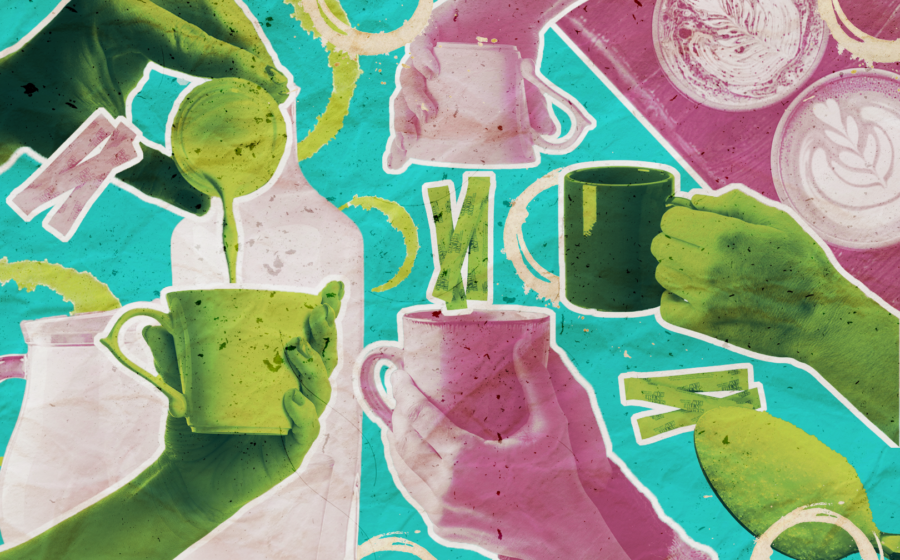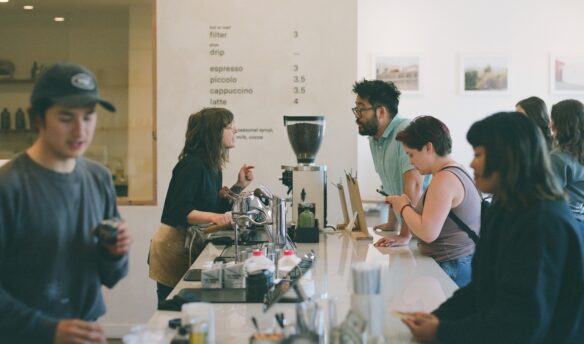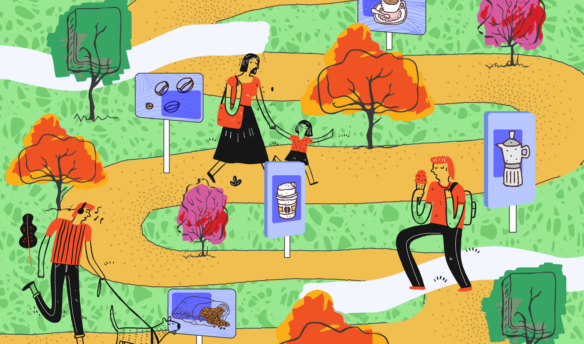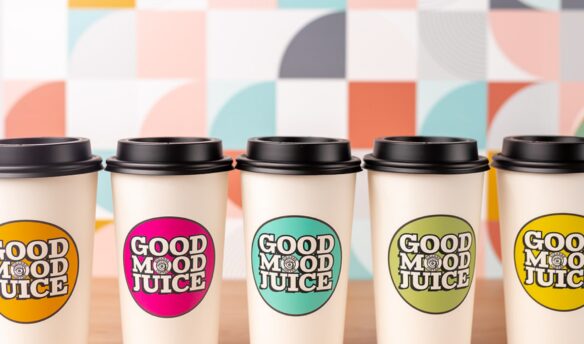Bubbles of dried milk on the countertop, sugar packets half-opened and scattered like sand, crumpled-up straw wrappers thrown about—looking for a home in the trash can and missing the mark.
We’ve all elbowed our way through a condiment bar. After receiving a cup of coffee, you’ve likely had to make the treacherous walk to a lonely little cart with a simple wish to add milk and sugar to your drink, only to find an empty half-and-half carafe, packets of sweetener you’ve only seen at the bottom of your grandmother’s purse, and a businessperson on the phone blocking the container of stirring sticks.
The condiment bar used to be a tool to save baristas time: if people wanted to add milk or sugar to their coffee, they could take it to the condiment bar and mix it up themselves. The pandemic virtually wiped them out—and their attendant mess—as coffee shops attempted to reduce touch points for customers and avoid cross-contamination.
While the pandemic eliminated many condiment bars, the question of their purpose and role in coffee began popping up even before they were considered a COVID hazard. An article in Fresh Cup in 2016 likened the practice of serving a customer a coffee and then sending them to the condiment bar to a bartender letting patrons add their own vermouth to a Manhattan. A bartender would never pass over an incomplete beverage to a customer, so why should a barista?
Many coffee shops ditched the condiment bar system in the early days of COVID, preferring to add milk and sugar behind the bar to avoid cross-contamination. Once shop owners saw the impact that removing the condiment bar had on their cafés, many never went back.
Getting Rid of the Condiment Bar For Good
In 2019, Ara Ajounian opened Mugshot Coffee in Los Feliz, Los Angeles. Mugshot switched from a self-serve condiment bar to having the baristas put milk and sugar in customers’ coffee during COVID and never switched back. Baristas kept simple syrup and single-serving sugar packets on hand, and if customers asked for a drink to be sweetened while ordering, they’d use the simple sugar. “When individuals wanted to put their own sugar in, we’d give [packets] to them,” Ajounian says. Baristas added milk visually, pouring it in front of customers and asking them to say ‘when,’ similar to how a server in a sit-down restaurant would pour milk for a customer.
If kids were making a mess [at the condiment bar], it wasn’t a big deal, but if there’s only one person working, it was a problem to clean up. It made the employee working uncomfortable and rushed. Ara Ajounian, mugshot coffee
It was just cleaner this way, Ajounian said. “You don’t know where [people] have been, what they’ve done, or where their hands have been,” he explained. Preventing customers from touching a container of sugar or milk kept the space germ-free. Keeping milk containers behind the bar also meant they could be held in the refrigerator, decreasing the likelihood of spoiling and reducing waste.
Eliminating the condiment bar also had additional benefits: baristas were less stressed and didn’t have to worry about constantly checking to see if the bar was stocked and tidy. “If kids were making a mess [at the condiment bar], it wasn’t a big deal,” says Ajounian, “but if there’s only one person working, it was a problem to clean up. It made the employee working uncomfortable and rushed.” Keeping an eye on the condiment bar distracted baristas from operating the register and making drinks.
Mugshot was a small space, and removing the condiment bar freed up counter space where customers could stand and chat before continuing their day. The shop has closed now, but Ajounian is in talks to open another shop later this year. Talks are in the early stages, but the lessons he learned from Mugshot—including how condiment bars impact barista workflow and a customer’s experience—will inform how he builds out a future space.
Relics of the Second Wave
At Go Get ‘Em Tiger, a condiment bar was never on the menu. Cream and sugar have always been the province of the baristas at the Los Angeles-based mini-chain, though they will hand over milk jugs and sweeteners to customers to add themselves. However, if a customer orders in advance, the team has “various sweetening levels and cream levels that [we] use internally to achieve what [we] think is an optimal balance” between coffee and additives, says owner Kyle Glanville.
Glanville mentions that the system “makes things a little harder” for the baristas working. At the same time, Glanville has “always believed that if you put something out for customers, that represents an endorsement or suggestion.” If cafés encourage customers to put sugar in their coffee, they will. Through the power of suggestion, having sugar or cream visible to customers implies that the beverages need them, encouraging customers to add sweeteners and milk before they even taste the coffee.
Readily available milk and sugar can imply that the coffee doesn’t stand on its own, which Glanville wants to avoid. “Our coffees and espresso drinks are designed to strike what we believe is already an optimal balance, so our suggestion to customers is to order from the menu and drink as served,” he says. “That said, we always happily accommodate a different preference.”
Baristas at Go Get ‘Em Tiger use a gram scale to measure the sweetener they add to drinks. They have specific units of measurement for simple syrup, referred to as “semi-sweet,” “sweet,” and “extra sweet,” and customers pick up the terminology quickly.
Going further, Glanville says that the sustainability of specialty coffee depends on divorcing added milk and sugar from every cup. “If we care about coffee quality, and the sustainability of a coffee movement rooted in quality, we need more folks drinking single-origin coffees that express terroir and the craft of a dedicated farm team. They just won’t get there if they keep adding cream to coffee,” Glanville said.
Our coffees and espresso drinks are designed to strike what we believe is already an optimal balance, so our suggestion to customers is to order from the menu and drink as served. That said, we always happily accommodate a different preference. Kyle glanville, go get ’em tiger
Both Ajounian and Glanville mentioned that customers occasionally flinch at this new style. “Most of our customers want to feel in control of their ratio!” Glanville said. Drink customizations are directed by personal preference, and many customers have developed a ritualistic approach to their drinks. Once customers get into the habit of adding milk and sugar, it can be challenging to break that habit.
There are plenty of arguments for and against the continued presence of condiment bars in coffee shops. The various factors of employee satisfaction, customer contentment, coffee quality, and shop real estate make for a more complex discussion than at first glance. Does having a condiment bar take up space where another table for guests could be? Which system is easier on employees: customizing all drinks or giving customers control? These questions are going to be answered differently by different teams.
For some, the question goes beyond convenience—the condiment bar represents a vestige of a different era of coffee service. “I think they are the product of a different time,” Glanville says. “For Go Get ‘Em, we see ourselves as professionals working in service of revealing a coffee’s true character. No thoughtfully sourced and well-roasted coffee is at its best when creamed or sugared, and I hope that the practice (in quality first cafes) becomes a relic of the past.”















